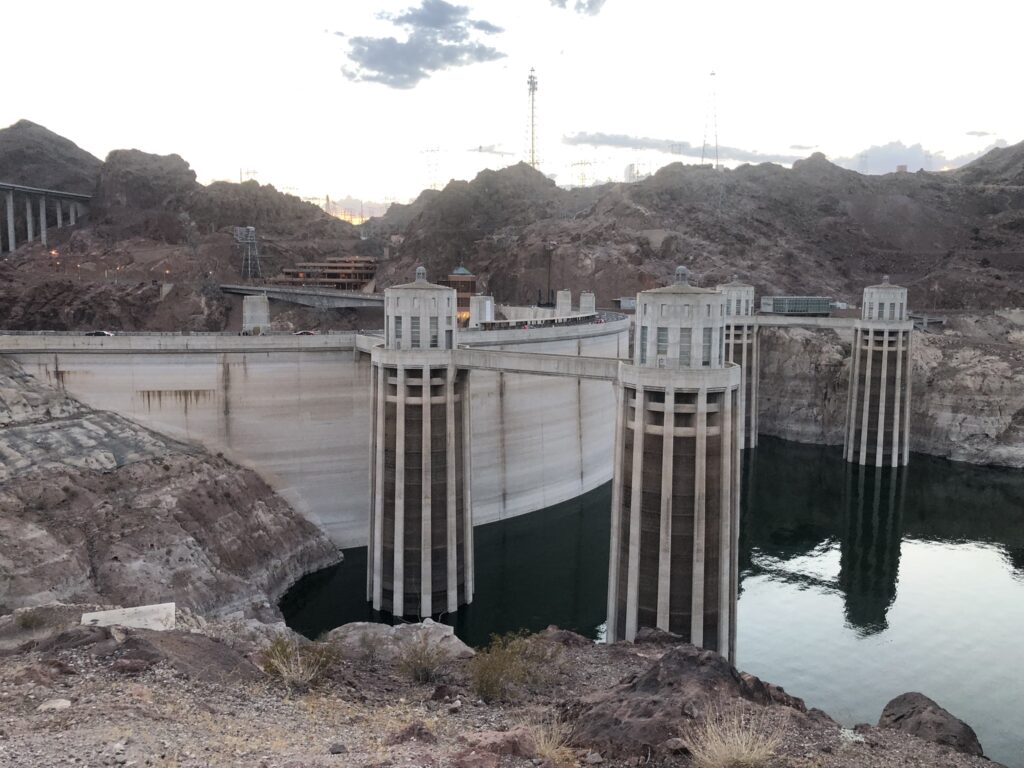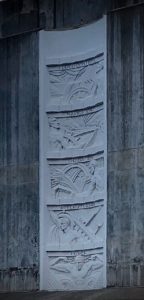
Hoover Dam in the fading light of a hot summer evening
A water nerd friend and I made a pilgrimage yesterday evening to Hoover Dam, spanning the Colorado River on the Arizona-Nevada border.
We’d had dinner at one of the restaurants on the docks at Hemenway Harbor, and driven up to the old abandoned boat ramp at Boulder Harbor, two Lake Mead landmarks for me, places I often visit. It was late, and hot as hell, and we were tired, but it didn’t take much persuasion for my friend to say “yes” to a last stop at Hoover Dam.
I’m here in Southern Nevada to be part of a PBS Newshour livestream Wednesday: “Tipping Point: Colorado River Reckoning.” I came out a couple of days early to see some friends and do the sort of “place-based” stuff that’s at the heart of my Colorado River work. I’ve been coming to this place – Lake Mead and Hoover Dam – for the last 15 years, watching the reservoir rise and fall, using this place as a conceptual anchor as I write my books.
My best guess based on hazy childhood memory is that I first visited Hoover Dam 60 years ago. We were on our annual summer car-camping trip, and I remember five-year-old John being both awestruck and uneasy – a bit frightened? – at the scale of the thing. Many years later, on one of many return trips, I stumbled on the thing that I remember most vividly: off the side of an embankment, massive concrete plugs that had been removed from the turbine tubes, dumped off the old rail line, lying today in a ravine.
It was a vague thing, fuzzy and just out of reach, but seeing them again on a bike ride along the Hoover Dam rail trail, the memory jumped up out of the ravine at me. As my friend remarked when I told them the story last night, I got bitten early.
Deb Chachra and the social nature of infrastructure
In an interview published last week in Public Books, the engineer Deb Chachra said a kaching thing about Hoover Dam that captures why I keep coming here, why I anchor so much of my thinking in the dam itself:
To borrow an idea from Joan Didion, who used it to describe driving in Los Angeles, these older forms of infrastructure, especially charismatic megastructures like bridges and train stations, can be secular cathedrals. We recognize that these are things that we made for ourselves and for each other. People have been visiting the Hoover Dam in droves since it was brand-new, so I don’t think it’s nostalgia per se—I think it’s more about celebrating this idea of the collective, these collective or communal projects. If we’re nostalgic, I think it’s less about the physical structures and more about the idea of working collectively.

The Boulder Canyon Project Act, carved in stone
Five years ago, on my umpty-first tour of Hoover Dam, a friend steeped in the “law of the river” led me to the elevator tower on the dam’s Nevada side to look at the decorative frieze. It’s a stone carving (or maybe cast concrete), visualizing the statutory purposes embodied in the Boulder Canyon Project Act, the act of Congress that authorized construction of the dam.
Be it enacted by the Senate and House of Representatives of the United States of America in Congress assembled, That for the purpose of controlling the floods, improving navigation and regulating the flow of the Colorado River, providing for storage and for the delivery of the stored waters thereof for reclamation of public lands and other beneficial uses exclusively within the United States, and for the generation of electrical energy as a means of making the project herein authorized a self-supporting and financially solvent undertaking, the Secretary of the Interior, subject to the terms of the Colorado River compact hereinafter mentioned, is hereby authorized to construct, operate, and maintain a dam and incidental works in the main stream of the Colorado River at Black Canyon or Boulder Canyon…. (emphasis added)
This is what Chachra is talking about. We often view Hoover Dam as a remarkable achievement of physical engineering, and it is. But it is, more importantly, an act of collective will. We came together in the 1920s, in community, to envision a desired future – of cities and farms in a place with too little water for either without infrastructure. We wrote a set of rules – the Colorado River Compact, the Boulder Canyon Project Act – that instantiated that collective will in the construction of a physical object – Hoover Dam.
And then we did the same thing, again and again, across the West. This enabled the places that tens of millions of us now call home.
Yesterday evening it was 110F (43C) after sunset, the parking lots were closed, and the tourists still came. My friend, who may be more of a Hoover Dam/Lake Mead/Colorado River nerd than I am (this is saying a great deal) was talking about the dam’s aesthetics – the care paid to the art deco flourishes – like the Boulder Canyon Project Act frieze. It’s a testament to the understanding of the people who built it that it was more than physical infrastructure – that it was a monument to collective action, the point Chachra so eloquently made.
This is why I’m confident, despite the current conflicts over how to share the shortages we face as a result of climate change, that we’ll figure things out. Collective action is at the heart of what we’ve been doing, it’s often hard, but we do it.
A note on Chachra’s book
Chachra’s book, How Infrastructure Works, is a terrific look at the social nature of infrastructure. Highly recommended.

Terrific writing that well complements Deb Chachra’s quote. “To borrow an idea…I think it’s less about the physical structures and more about the idea of working collectively”.
Thanks for what you do. I so enjoy reading what could be called spiritual geography, or spiritual civil engineering. It speaks to something beyond water.
We all have water stories and what we experienced as a kid. I’ll tell you my story. I grew up in Minneapolis and had an interest in the Mississippi River. Saw the source in northern Minnesota when on vacation when I was six. The river was no more than a creek and less than a foot deep where it exited Lake Itasca. I learned how to swim in the Mississippi and fished below the Coon Rapids Dam as a teenager. Also at this time I got fascinated with Dams. Most of the Dams I went to were on fishing expeditions with my dad. I learned about Hoover Dam while in grade school. Like everyone reading my post, this dam had a mystique about it. One day I was going to see it…and see it I did.
In 1992 I got my chance. I was working in DoD working on overseas projects and thinking that I needed to get a change of scenery. A coworker of mine got hired by Shasta Dam and he loved the work. That set the hook into me. Some weeks later I spot a job announcement. Guess where? Hoover Dam. I fill out the job application and bingo, six weeks later I get notified that I’m hired.
At this point I know absolutely nothing about hydro power generation, the GRID or water management. Over the course of years I learned about the nuances of how everything is intertwined. I also got a deep appreciation for how it was built and the engineering that went into the place. There are so many things that you pick up over time in conversations with old timers and insiders that never are recorded in the record. That is especially true of history.
As someone who has intimate knowledge of Hoover and all the dams below it, you tend to look at the infrastructure and the river (for that matter) as having unique personalities. The overall understanding of the big picture is a complex one.
As for me, I often tell my friends that getting to work at such an interesting place during interesting times made the last twenty five years of my career an enjoyable one.